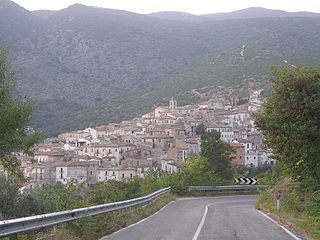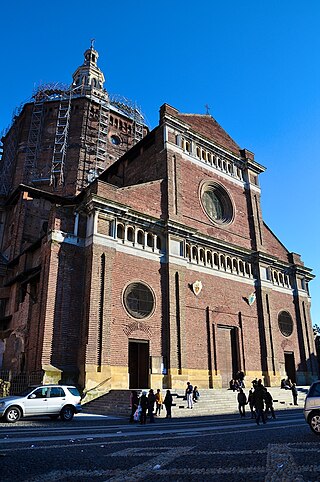Atella was an ancient Oscan city of Campania, located 20km directly north of Naples.

Ofena is a comune and town in the Province of L'Aquila in the Abruzzo region of Italy. It is located in the natural park known as the "Gran Sasso e Monti della Laga National Park". The comune/village is home to a vast and rich history of a community that has existed for many hundreds of years.

Arpaia is a town, comune (municipality) and former episcopal see in the Province of Benevento in the southern Italian region Campania, located about 35 km northeast of Naples and about 25 km southwest of Benevento.
Caudium was the main city of the ancient Caudini tribe in Samnium situated on the Appian Way between Beneventum and Capua, in what is now southern Italy. It was 21 Roman miles from Capua, and 11 from Beneventum. It, or nearby Arpaia, became the seat of an early bishopric, which is now a Latin Catholic titular see.
The Diocese of Cingoli was a Roman Catholic diocese in Italy. It was founded in the 5th century. Nothing is heard of the diocese or of its bishops after the sixth decade of the 6th century. The time and reason for its cease is speculative. It was contained within the Papal States. The diocese was always immediately subject to the Holy See (Papacy). The effort to revive the diocese of Cingoli was begun during the reign of Pope Innocent XIII, the initiative coming from the town of Cingoli itself. Having received their memorial, on 26 August 1721, the Pope requested from Cardinal Orazio Spada his comments on each of the items mentioned by the Public of Cingoli. Archbishop Giustino Fontanini prepared a memorial of the information relevant to making a decision; it was dated 20 May 1723. Unfortunately Pope Innocent died on 7 March 1724, before the bulls could be prepared. The matter was left to the new pope, Benedict XIII (Orsini). In 1725, by virtue of the Bull "Romana Ecclesia" of 19 August 1725, Pope Benedict XIII revived the diocese of Cingoli, and united it aeque principaliter with the Diocese of Osimo to form the Diocese of Osimo e Cingoli.

The Diocese of Pavia is a Latin diocese of the Catholic Church in Italy. It has been a suffragan of the Archdiocese of Milan only since 1817. Previous to the reorganization of the hierarchy in northern Italy by Pope Pius VII after the expulsion of the French and the Congress of Vienna, the diocese of Pavia had depended directly upon the Holy See, despite repeated failed attempts on the part of the Archbishops of Milan to claim control. The diocese has produced one Pope and Patriarch of Venice, and three cardinals.
Terentian(us) (Italian: San Terenziano) (died 118) was Bishop of Todi who was killed during the reign of Hadrian (117–138).

The Diocese of Concordia-Pordenone is a Latin diocese of the Catholic Church situated in northeastern Italy, at the northern end of the Adriatic Sea, between Venice and Udine. Since 1818, Concordia Veneta, has been a suffragan of the Archdiocese of Venice. Bishop Andrea Casasola attended the Provincial Council of the Provincia Veneta in October 1859 as a suffragan of the Patriarch of Venice, Cardinal Giuseppe Luigi Trevisanato. The name of the diocese was changed to its present form in 1971.

The Diocese of Biella is a Latin diocese of the Catholic Church in northern Italy, in the Piedmont region. The diocese was established in 1772. It is a suffragan of the Archdiocese of Vercelli. Biella is a city in Piedmont, 42 km (25 mi) northwest of Vercelli.

The Archdiocese of Salerno-Campagna-Acerno is a Latin Church diocese of the Catholic Church in Campania, southern Italy, created in 1986. The historic Archdiocese of Salerno was in existence from the tenth century, having been elevated from a sixth-century diocese. The Diocese of Acerno was combined with the archdiocese in 1818.

The Diocese of Sulmona-Valva is a Latin diocese of the Catholic Church in central Italy, in the Abruzzi region, approximately 120 km (75 mi) directly east of Rome. Corfinio (Valva) is 14 km north-northwest of Sulmona.

Saint Orontius of Lecce is venerated as a saint by the Catholic Church, along with two other figures associated with his legend, Fortunatus and Justus. He is viewed as the first bishop of Lecce.

Saint Canius was a Roman Catholic bishop and martyr, and patron saint of the cities of Calitri, Acerenza and its archdiocese. He may have been a descendant of the Roman gens Cania. He is venerated on 25 May.

Passo Corese is an Italian town and hamlet (frazione) of Fara in Sabina, a municipality in the province of Rieti, Lazio. In 2011 it had a population of 3,573.
Laurence of Siponto, also known as Laurence Maioranus, is an Italian saint, patron of the city of Manfredonia and the Archdiocese of Manfredonia-Vieste-San Giovanni Rotondo. Manfredonia Cathedral is dedicated to him. He is credited with founding the shrine to Saint Michael the Archangel on Mount Gargano.
Saint Pardus is a Roman Catholic saint associated with Larino in Italy. Larino Cathedral is dedicated to him.

The Mausoleum of Helena is an ancient building in Rome, Italy, located on the Via Casilina, corresponding to the 3rd mile of the ancient Via Labicana. It was built by the Roman emperor Constantine I between 326 and 330, originally as a tomb for himself, but later assigned to his mother, Helena, who died in 330.
The Roman Catholic Diocese of Pesto was a bishopric, later under the name of Capaccio, and became a Latin Catholic titular see in 1966.

Cassius and Castus were two African bishop-martyrs, particularly venerated in Benevento, Calvi, Capua, Sora, Gaeta and other nearby towns in Campania and Lazio. Their feast day is 22 May, shared with Castus and Emilius.

Priscus of Nocera was the first bishop of Nocera, patron saint of the city of Nocera Inferiore and of the diocese of Nocera Inferiore-Sarno.













